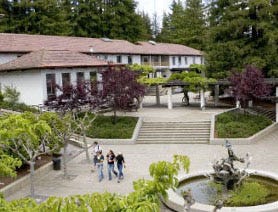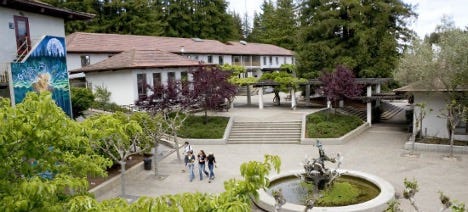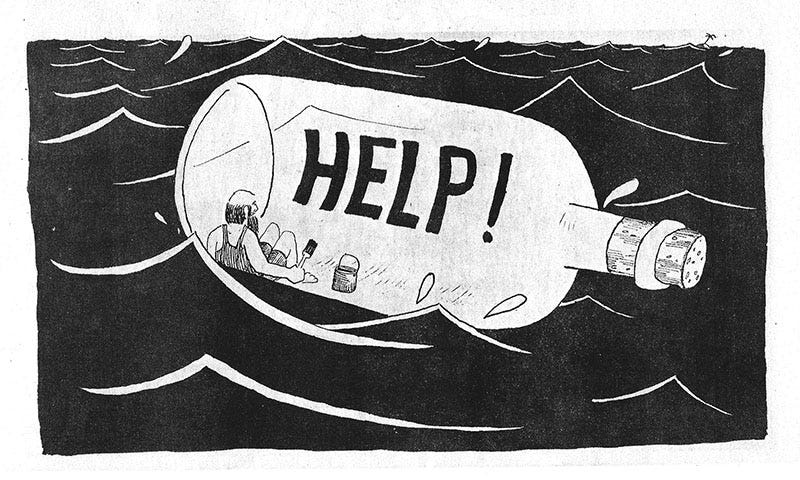WONDERCABINET : Lawrence Weschler’s Fortnightly Compendium of the Miscellaneous Diverse
WELCOME
This week, a pop quiz on the relative ages of late Soviet and current American would-be leaders; followed by a utopian vision for future colleges based on past kindergartens; and finally, Naomi Klein’s powerful address at the other day’s Passover in the Streets.
* * *
POP QUIZ
Readers of a certain age might well recall that sclerotic trill of pathetically superannuated consecutive leaders towards the end of the Soviet Union—one after the next, from Brezhnev to Andropov and then on through Chernenko—until they finally got to Gorbachev, by which time it was all too late—
how proceeding like that, one after the next, they seemed veritably to embody the sagging exhaustion of the system they still seemed so intent on perpetuating.
Okay. So how old do you think they were when they finally died, each in turn.
Answer: Brezhnev, dead at 75. Andropov, 69. And Chernenko, 73.
If and when Joe Biden and Donald Trump debate each other later this year, they will respectively be 81 and 77.
Just saying (said our host, granted, himself at 72, though in fairness he is not putting himself forward as a sensible candidate for the presidency).
*
For a sobering survey of more general tendencies in this regard across wider swaths of the American political scene (viz: “In 2014 the US elected the oldest Congress in its history. The record did not last long: It was broken in 2016. And then again in 2018. And yet again in 2020, when—remarkably—the majority of the incumbents who lost their seats were replaced by someone even older. In the 2022 midterms, the House did become slightly younger (the mean age of representatives dropped by a year, from fifty-nine to fifty-eight), but the mean age of senators continued to rise and is now over sixty-five”), see Fintan O’Toole’s scathing piece “Eldest Statesmen” in the New York Review of Books of several weeks back. Yikes.
* * *
The Main Event
The piece that follows takes off from where the lead piece in our last full substack left off. Readers of that one may recall how it surveyed the mid-19th century origins of kindergarten in its original conception, that of a Swiss-German crystallographer named Friedreich Froebel who prized exposing his young charges to patterning and pattern-recognition rather than reading, ‘riting and ‘rithmatic, doing so across a sequence of twenty exactingly modulated “gifts” (boxed combinations of blocks and tiles and paper-weavings and dried peas and toothpicks and the like) offered one after the next as each child grew ready for the sequel—a model that spread throughout the world during the latter decades of the nineteenth century and indeed clearly seeded the upwelling of worldwide avant-garde artistic and scientific trends early in the twentieth. Readers are invited to revisit that story as I presented it there or else in the first several paragraphs of the piece that follows in its original form, paragraphs that I have omitted here but that started out by recapitulating that history before using it as a springboard for speculations regarding the design of a possible utopian college of the future.
From the Archives
Back to Kindergarten!
A Modest Proposal for a College of the Future
{…} What we are given to understand across Brosterman’s and now Wertheim’s and Kuhn’s work is nothing less than the way many of the greatest avant-garde breakthroughs of the twentieth century were being incubated in the kindergarten classrooms of the nineteenth.
Which in turn is what has gotten me to musing about colleges at the outset of the twenty-first. (I will set aside, for the moment, any thought on the comparative aridity of most contemporary pre-school practices.) No point rehearsing at any great length all the problems and challenges facing post-secondary education these days—the exponentially spiraling costs; the hypertrophy of administrators (not unrelated to the first, incidentally); the exploitation of adjuncts and graduate students; the spirit-sapping pressures on the students (both before and after they arrive); grade inflation to the point of meaninglessness; the privileging of ever more esoteric research over general education; the mind-deadening regimentation of the syllabus (or else its opposite, the diffusion of oversight and responsibility for individual outcomes); the relentless compression of space and time for daydreaming and general dalliance; and so forth.
I just find myself wondering if the nineteenth-century conception of kindergarten might hold some clues as to a way out. I just find myself fantasizing. (There’s a hell of a good universe next door, let’s go!)
*
What if we were to found a new college? (I know, I know: I’m reminded of a conversation I once overheard, geesh, coming up on five decades ago, sitting at an outdoor café in Carmel: two women of a certain class and a certain age—not my class by a long shot, and younger it occurs to me than I am now—conversing at the neighboring table, till at length, after a long pause, one of them tentatively said to the other, “The thing is, I don’t want a job. I want … I want … I want to found something.”) But seriously. What if we were …? (I suppose I come by this way of thinking honestly: I was a student during the glory decade following the founding of the University of California’s experimental campus at Santa Cruz, and at Cowell College there we used to talk about foundings all the time.) What if …? (I remember, for instance, studying the history of medieval monasteries, the sort of thing we were really into, there among the redwoods; how they’d get founded and grow but then inevitably start to rigidify and ossify, until presently, with everything all gummed up and ground down, a group of adventurous monks would launch out and journey forth, eventually founding a whole new monastery somewhere else, gloriously animated by fresh ideals and flush with eager promise.)
As long as we’re just blue-skying here, why don’t we conjure ourselves, at least at the outset, a faculty of fifty for a student body of, say, six to seven hundred. The main thing would be the selection of the faculty, and here a simple criterion would prove central: whether they were the sort of people who would be willing to take active part, at least once every four years on a rotating basis, in the concentrated freshman core course, because that core course would prove the very soul of the place, the originary essence of the experience on offer.
And as far as that core course goes, I take as my entry point the premise that any kid arriving at college nowadays has likely just survived at least two years of sheer academic hell: the eleventh and twelfth grades of high school having been given over to high-pressure test preparation, test taking, too many AP classes and exaggerated GPA expectations, and all the rest of contemporary college-selection hysteria. (In my {then-} current capacity as the director of a humanities institute, I’ve long been threatening to convene a conference around the theme of “Sub-Saharan Clitoridectomy or North American College Application Process: Which is Stupider?,” prior to which we’d recruit three anthropologists from Africa to come live, say, in Westchester County, for six months just to observe late-secondary-school education and its attendant processes, and then offer up a report on the harrowingly bizarre rituals they’d gotten to witness, the anxiously freighted rites of passages imposed on the youngsters—all supposedly, as with clitoridectomies, for their own eventual good.) That is, I am working from the assumption that as they arrive on campus, the survivors of such regimes have been entirely drained of free-floating curiosity let alone the love of learning, and that that is the first thing the college is going to need to reinstill.
Hence the core, to be titled Play/Ground—a yearlong course that would take up at least half of the students’ (and the participating faculty’s) workload that first year. Every year, twelve members of the faculty would be peeled off to run the core (a different twelve each year, in a general four-year rotation), chosen to reflect the widest possible range of disciplines: a musicologist, say, and a physicist, a political theorist, a climatologist, a classicist, a microbiologist, a historian of Islam, a sculptor, an information scientist, an economist, and so forth. All the students and faculty in the core would gather together in a large lecture hall every Monday morning for a sequence of three-week minicourses offered, one after the next in turn, by each of the participating faculty, in which said teacher (the musicologist for three weeks, and then the physicist, the political theorist, and so forth) would be expected to take the class on a concentrated tour of one aspect or issue or controversy in their discipline. For the rest of the week, to further explore themes raised by that three-week series of lectures (and then the next and then the next), the class would be broken up into twelve seminars of ten to twelve students, each led by one of the participating faculty (groupings that would meet two or three times a week and stay together through the entire year). Key here would be the fact that in most cases, the faculty leader wouldn’t necessarily be any more conversant with the topic in question than his or her charges: he or she would just have a better sense of how to use the library, how to read, how to hone questions, et cetera. (Though one might imagine a parallel seminar in which the participating faculty themselves would meet on a weekly basis to receive added instruction and compare notes on how the course was proceeding.)
Play/Ground: a grounding, that is, in the spirit of play across a succession, as it were, of gifts. The entire enterprise would be pitched to a sense of discovery and wonder—no grades (at most, pass-fail)—and the entire college would build itself around that Play/Ground core. As I say, faculty would be chosen precisely on the basis of both their willingness and capacity to take part in this sort of teaching (which I am the first to acknowledge is not for everyone); and such a passion for teaching and openness to that sort of cross-fertilization would, one hopes, carry over into the rest of their college work: in other words, not a bad metric by which to recruit a specific kind of faculty. Monday mornings would be kept free of any other campus programming, so that everyone in the college could sit in on the lectures (over the four years of their residence, students thus would have an opportunity to sample almost fifty different three-week minicourses).
The dream being that someday, thirty or forty years on, when, say, a climate scientist gets asked, “How did you ever decide to become a climate scientist?,” she might answer, “Well, I went to this crazy college where my freshman year we got exposed to this whole wacky range of topics, and there was this one series of talks on climate science, and I’d had no prior idea, but I just fell in love with the stuff.”
Now, speaking of climate and the limitations of blue-skying, the actual founding of such a college may just be too much of a stretch. It would at any rate require a stretch in the way we think about such places: no lavish athletic facilities or imperial student unions, for example, or for that matter any cutting-edge science labs, or elaborate theater spaces. Furthermore, if part of the brief were to keep costs and fees down, we’d likely need to locate it someplace cheap: ideally someplace grand that may have fallen on hard times but nonetheless retains a once splendid infrastructure of libraries and concert halls and museums and surrounding colleges, or at any rate the plausible renewals of same: someplace, say, like Detroit, with its newly open spaces, its fine housing stock gone to seed, the sort of place we could command sufficient space and our faculty and staff could aspire to comfortable houses and lives despite the relatively low salaries we’d be able to afford to pay them, at least at the outset. And offering lower salaries than elsewhere might itself help limit the sort of faculty who’d apply. (I’d like to think we’d get a smattering of superb senior or mid-career faculty from top places willing to settle for lower salaries in exchange for the opportunity to escape the sclerotic administration-heavy confines of their home institutions and revivified by the idealistic challenge of founding something new—Santa Cruz certainly did in its heyday. As for the rest, never have there been so many superbly trained young PhDs hankering, almost hopelessly, for gainful employment: we’d have our pick. For that matter, we might not need to confine ourselves to PhDs: rather we’d be seeking out superbly gifted teachers, who come in all sorts of varieties.)
But even if we weren’t able to found an entire college, the thought experiment might not be without its rewards. I tend to doubt it would be possible to get an entire existing college to shift over to this way of thinking: there’d likely be just too much resistance among threatened vested elements of the faculty and the administration. But it might still be possible to carve out an experimental college within a wider university, for example, to which some existing faculty might be drawn. (I’ve always imagined that at Santa Cruz, specifically, architecture may yet prove to be destiny: that even though the original emphasis on smaller individual colleges as the organizing principle of the place has long fallen victim to a wider emphasis on university-wide divisions and boards of study, such that nowadays neither faculty nor students feel any particular loyalty to their ostensibly assigned colleges, still that’s how the place was originally built, with distinct individual colleges, and one of these days a group of faculty and students may once more tap into the originary spirit of the place: why don’t we just take over one of these colleges and try something new?)
The wider point though is that new thinking is desperately called for: and where better to go looking than back in the nineteenth century, at some of the freshest educational initiatives ever undertaken? Back, that is, to first things. Back to kindergarten!
* * *
NOT TO BE PASSED OVER
This past Tuesday, April 23rd, 200 days since the beginning of the Gaza War, happened to coincide with the second evening of this year’s Passover, one of the Jewish calendar’s holiest days, and thousands of mostly Jewish observers gathered in Brooklyn’s Grand Army Plaza (a few hundred yards from Senate Leader Chuck Schumer’s home) to celebrate a so-called Seder in the Streets. Following the ritual dipping and eating of the Bitter Herbs, Naomi Klein, one of our perennial heroes here at the Cabinet, rose to address the crowd, as follows:
I’ve been thinking about Moses, and his rage when he came down from the mount to find the Israelites worshipping a golden calf.
The ecofeminist in me was always uneasy about this story: what kind of God is jealous of animals? What kind of God wants to hoard all the sacredness of the Earth for himself?
But there is a less literal way of understanding this story. It is about false idols. About the human tendency to worship the profane and shiny, to look to the small and material rather than the large and transcendent.
What I want to say to you tonight at this revolutionary and historic Seder in the Streets is that too many of our people are worshipping a false idol once again. They are enraptured by it. Drunk on it. Profaned by it.
That false idol is called Zionism.
It is a false idol that takes our most profound Biblical stories of justice and emancipation from slavery – the story of Passover itself – and turns them into brutalist weapons of colonial land theft, roadmaps for ethnic cleansing and genocide.
It is a false idol that has taken the transcendent idea of the promised land – a metaphor for human liberation that has traveled across multiple faiths to every corner of this globe – and dared to turn it into a deed of sale for a militaristic ethnostate.
Political Zionism’s version of liberation is itself profane. From the start, it required the mass expulsion of Palestinians from their homes and ancestral lands in the Nakba.
From the start it has been at war with dreams of liberation. At a Seder it is worth remembering that this includes the dreams of liberation and self-determination of the Egyptian people. This false idol of Zionism equates Israeli safety with Egyptian dictatorship and client states.
From the start it has produced an ugly kind of freedom that saw Palestinian children not as human beings but as demographic threats – much as the pharaoh in the Book of Exodus feared the growing population of Israelites, and thus ordered the death of their sons.
Zionism has brought us to our present moment of cataclysm and it is time that we said clearly: it has always been leading us here.
It is a false idol that has led far too many of our own people down a deeply immoral path that now has them justifying the shredding of core commandments: Thou shalt not kill. Thou shalt not steal. Thou shalt not covet.
It is a false idol that equates Jewish freedom with cluster bombs that kill and maim Palestinian children.
Zionism is a false idol that has betrayed every Jewish value, including the value we place on questioning – a practice embedded in the Seder with its four questions asked by the youngest child.
Including the love we have as a people for text and for education.
Today, this false idol justifies the bombing of every university in Gaza; the destruction of countless schools, of archives, of printing presses; the killing of hundreds of academics, of journalists, of poets – this is what Palestinians call scholasticide, the killing of the means of education.
Meanwhile, in this city, the universities call in the NYPD and barricade themselves against the grave threat posed by their own students daring to ask them basic questions, such as: how can you claim to believe in anything at all, least of all us, while you enable, invest in and collaborate with this genocide?
The false idol of Zionism has been allowed to grow unchecked for far too long.
So tonight we say: It ends here.
Our Judaism cannot be contained by an ethnostate, for our Judaism is internationalist by nature.
Our Judaism cannot be protected by the rampaging military of that state, for all that military does is sow sorrow and reap hatred – including against us as Jews.
Our Judaism is not threatened by people raising their voices in solidarity with Palestine across lines of race, ethnicity, physical ability, gender identity and generations.
Our Judaism is one of those voices and knows that in that chorus lies both our safety and our collective liberation.
Our Judaism is the Judaism of the Passover Seder: the gathering in ceremony to share food and wine with loved ones and strangers alike, the ritual that is inherently portable, light enough to carry on our backs, in need of nothing but each other: no walls, no temple, no rabbi, a role for everyone, even – especially – the smallest child. The Seder is a diaspora technology if ever there was one, made for collective grieving, contemplation, questioning, remembering and reviving the revolutionary spirt.
So look around. This, here, is our Judaism. As waters rise and forests burn and nothing is certain, we pray at the altar of solidarity and mutual aid, no matter the cost.
We don’t need or want the false idol of Zionism. We want freedom from the project that commits genocide in our name. Freedom from an ideology that has no plan for peace other than deals with murderous theocratic petrostates next door, while selling the technologies of robo-assassinations to the world.
We seek to liberate Judaism from an ethnostate that wants Jews to be perennially afraid, that wants our children to be afraid, that wants us to believe the world is against us so that we go running to its fortress and beneath its iron dome, or at least keep the weapons and donations flowing.
That is the false idol.
And it’s not just Netanyahu, it’s the world he made and that made him – it’s Zionism.
What are we? We, in these streets for months and months, are the exodus. The exodus from Zionism.
And to the Chuck Schumers of this world, we do not say: “Let our people go.”
We say: “We have already gone. And your kids? They’re with us now.”
Following which, hundreds of the (again) mostly Jewish demonstrators were arrested by the New York City Police.
Meanwhile, back in Jerusalem, Prime Minister Netanyahu took to the airwaves to denounce the way that “What’s happening on American college campuses is horrific. The Anti-Semitic mobs that have taken over leading universities must be confronted,” and so forth. And a senior Israeli defense official declared that “The Israel Defense Forces have conducted all necessary preparations to take Gaza’s southernmost city of Rafah and can launch an operation the moment it gets government approval.”
Take note, and stay tuned.
* * *
ANIMAL MITCHELL
Cartoons by David Stanford, from the Animal Mitchell archive
animalmitchellpublications@gmail.com
* * *
OR, IF YOU WOULD PREFER TO MAKE A ONE-TIME DONATION, CLICK HERE.
*
Thank you for giving Wondercabinet some of your reading time! We welcome not only your public comments (button above), but also any feedback you may care to send us directly: weschlerswondercabinet@gmail.com.
Here’s a shortcut to the COMPLETE WONDERCABINET ARCHIVE.












I was a preschool teacher for forty years-- the first twenty in Montessori classrooms, and the last twenty in a play-based parent co-op. Over and over again I saw my students, who adored school and nagged at parents to bring them even during weekends and vacations, transformed into "bored," stressed, unenthusiastic elementary, middle-school and highschoolers. Play is at the heart of all learning, and adult play usually involves the flow state, where we follow our interests and passions deep into the heart of a topic. I think your play/ground program sounds wonderful and I'd happily enroll!
https://m.youtube.com/watch?v=qokhPdgvgw0
Incredibly raw and heartfelt and beyond cogent, this Survivor refuses to stay silent as his suffering is appropriated to justify the murder of Gaza innocents. In an ongoing declaration to champion humanity over politics and indifference, this sadly needs to be seen and heard.